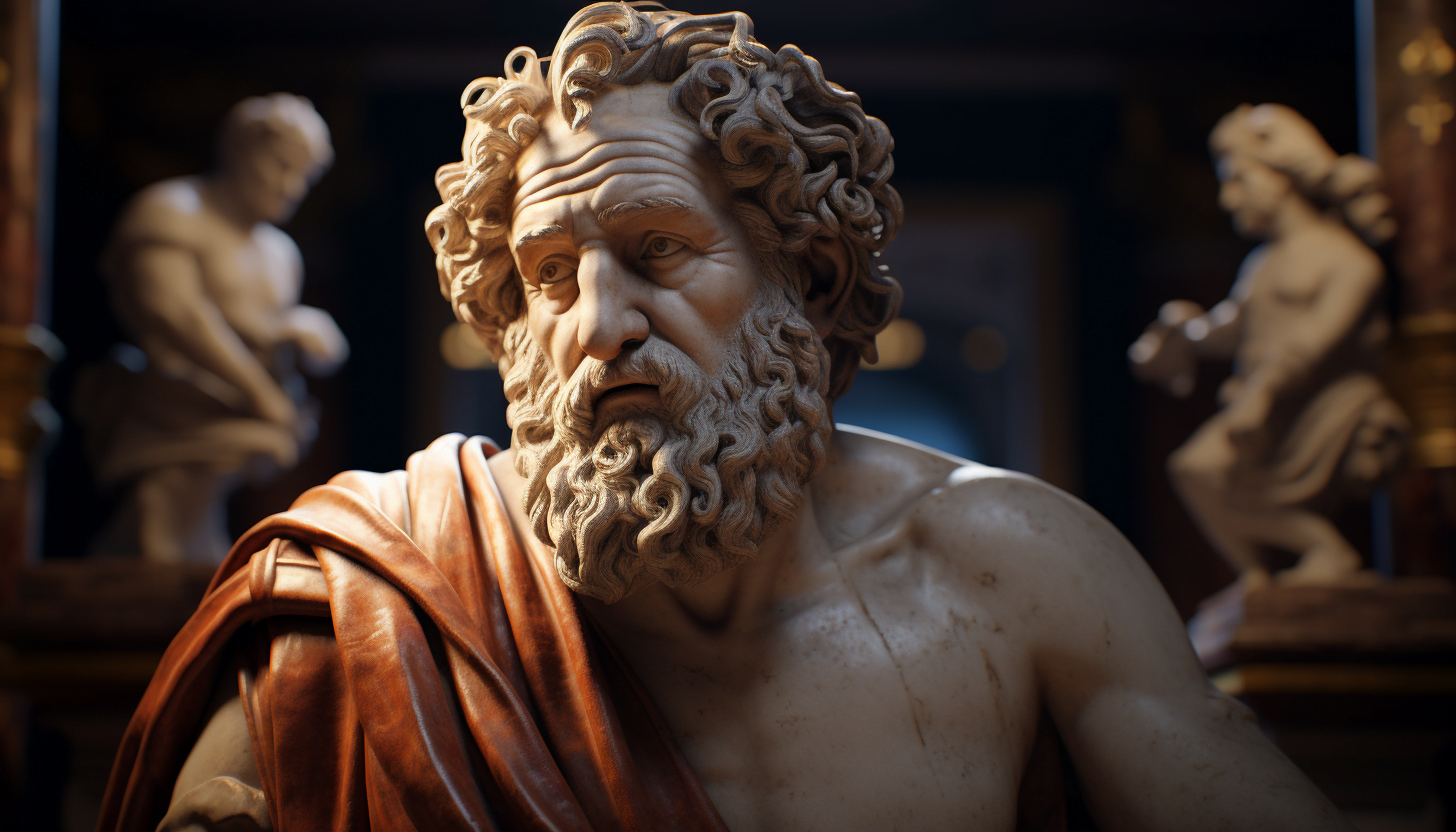Have you ever wondered about the origins of the universe and what lies at the very core of everything we see around us? Enter Democritus, an ancient Greek philosopher who devoted his life to unraveling the fundamental nature of matter. His groundbreaking theory known as Democritus’ Atomic Theory has laid the foundation for our modern understanding of the microscopic world. In this article, we will delve into the intriguing world of Democritus’ theory, exploring the life of the man behind it and unraveling the principles that have shaped our perception of the atomic realm. Brace yourself for an illuminating journey through the depths of ancient wisdom!
🔗 Explore More: Dive into the fascinating world of Democritus’ atomic theory and discover intriguing Democritus facts that unveil the enigma!
Explanation of Democritus’ Theory
Democritus, a Greek philosopher born in the 5th century BC, is renowned for his groundbreaking atomic theory. In a nutshell, his theory proposes that all matter consists of tiny, indivisible particles called atoms. These atoms are infinite in number and perpetually in motion, combining and separating to form various substances.
In Democritus’ view, atoms are eternal and unchangeable. They differ from one another in size, shape, and arrangement, thereby giving rise to the diverse properties we observe in the world around us. This concept challenges the prevalent belief of his time, which suggested that matter could be infinitely divided.
To better comprehend this theory, let’s use a simple analogy. Imagine a Lego set—each Lego brick represents an atom. Just as these Lego bricks come in different shapes, sizes, and colors, atoms possess their own unique characteristics. By reassembling these bricks, we can construct an array of structures, just as atoms combine to form various substances.
Now, you might wonder how Democritus managed to propose such a revolutionary theory without access to modern scientific equipment. Although he lacked sophisticated tools, he employed logical reasoning and philosophical contemplation to develop his ideas. Democritus believed that human perception could be refined through reflective thinking and keen observation of the world.
It’s important to note that Democritus’ atomic theory not only laid the foundation for future advancements in physics and chemistry but also shaped our understanding of the fundamental nature of matter. As Albert Einstein once said, “The greatest revolution of our generation is the discovery that human beings, by changing the inner attitudes of their minds, can change the outer aspects of their lives.”
In conclusion, Democritus’ theory, with its bold assertion that matter is composed of indivisible particles, guided scientific inquiry for centuries to come. Through his insights, he unraveled the mysteries of the atomic realm, fostering our understanding of the building blocks of the universe and inspiring generations of scientists to explore the hidden depths of existence.
“Democritus’ atomic theory revolutionized our understanding of matter, unveiling the intricate dance of atoms that form the basis of our world.”
Democritus Atomic Model
The Democritus Atomic Model is a historically significant theory that delves into the fundamental nature of matter. Proposed by the ancient Greek philosopher Democritus, this model revolutionized our understanding of the physical world.
Democritus posited that all matter is composed of indivisible particles called “atoms.” According to his theory, atoms are infinite in number, constantly moving, and differ in shape and size. These atoms combine to form everything we see and experience around us.
Now, you might be wondering how this ancient theory relates to our modern understanding of atomic structure. Well, despite its simplicity, Democritus’ concept of atoms provides a solid foundation for the development of atomic models that followed.
It is crucial to note that Democritus’ theory was purely philosophical, lacking empirical evidence. However, it still offered a valuable perspective on the nature of matter, which resonates with scientific thought today.
Although Democritus’ model lacked the sophisticated experimental tools we have today, it highlights the timeless human curiosity to unravel the mysteries of the universe. This curiosity has driven scientists over the centuries to build upon the foundation laid by the ancient Greeks.
In conclusion, Democritus’ Atomic Theory, even though proposed more than two millennia ago, laid the groundwork for our modern understanding of the fundamental nature of matter. While empirical evidence and subsequent advancements have refined our understanding, Democritus’ insights paved the way for future discoveries. As Albert Einstein once said, “The only source of knowledge is experience” – and Democritus’ ideas continue to shape our scientific journey toward truth.
Who was Democritus?
Democritus, known as the “Father of Modern Science,” was an ancient Greek philosopher born in Abdera, Thrace around 460 BCE. He is renowned for his pioneering work in the field of atomic theory, which revolutionized our understanding of the fundamental nature of matter.
Early Life and Influences
Democritus was greatly influenced by Leucippus, a philosopher who developed the concept of atomism. This philosophy posits that everything in the universe is composed of indivisible particles called atoms. Democritus built upon this idea and expanded it through his own observations and theories.
Contributions to Atomic Theory
Democritus proposed that atoms are infinite in number and exist in constant motion. According to him, atoms are indestructible and indivisible, differing only in shape, size, and arrangement. These variations are responsible for the diversity of matter in the world.
He believed that atoms combine through hooks and eyes, an idea that might seem rudimentary today, but it laid the foundation for our current understanding of chemical reactions and bonding. Democritus also posited that the properties of substances arise from the arrangement and movement of their constituent atoms.
Influence on Science and Philosophy
Democritus’ atomic theory not only had a profound impact on the scientific community but also influenced philosophers such as Epicurus and Lucretius. His ideas laid the groundwork for future breakthroughs in understanding the physical world.
Despite his significant contributions to science, only a fraction of Democritus’ works have survived to this day. We know of his theories mainly through the works of later scholars who built upon his ideas.
Legacy and Significance
Democritus’ atomic theory was ahead of its time, challenging prevailing notions that matter was continuous and could be infinitely divided. His ideas paved the way for subsequent scientific discoveries, particularly during the Scientific Revolution.
To quote Democritus himself, “Nothing exists except atoms and empty space; everything else is opinion.” This succinctly captures the essence of his atomic theory and its revolutionary impact on our understanding of the universe.
In conclusion, Democritus’ atomic theory revolutionized our understanding of matter. His ideas on the existence, motion, and combining nature of atoms laid the foundation for scientific progress, influencing both scientific thought and philosophy. Today, his contributions continue to shape our understanding of the world at its most fundamental level.
What are the principles of Democritus’s Atomic theory?
Democritus’s atomic theory, developed around 400 BCE, revolutionized our understanding of matter. In this article, we will delve into the fundamental principles of his groundbreaking theory and explore its enduring significance in the world of science.
The Indivisibility of Atoms
At the core of Democritus’s atomic theory lies the concept that all matter is composed of indivisible particles called atoms. Imagine, if you will, dividing a substance repeatedly. By the time you reach a point where it cannot be further divided, you have arrived at the atom. According to Democritus, atoms are eternal, unchangeable, and indestructible, forming the building blocks of everything around us.
Infinite Variations and Combinations
Democritus asserted that not only do atoms exist in an endless variety of shapes and sizes, but they also possess different properties. This notion gave rise to the idea that different combinations of atoms result in the vast diversity of matter we observe in the universe. From the stars in the night sky to the tiniest grains of sand, every substance is a product of unique atom arrangements.
Constant Motion and Collision
Atoms, according to Democritus, are perpetually in motion. Their ceaseless movement leads to random collisions, allowing them to interact and form bonds with one another. These collisions occur within the void, an empty space that separates atoms. It is within this dynamic interplay of motion and collision that the complexity and richness of the physical world emerge.
Principle of Determinism
One of the most intriguing aspects of Democritus’s theory is the notion of determinism. He believed that everything that occurs, from the tiniest interactions to the grandest cosmic events, follows a predetermined path dictated by the behavior of atoms. Democritus’s deterministic worldview laid the groundwork for our current understanding of causality and the interconnectedness of all things.
“Democritus’s atomic theory profoundly challenged conventional wisdom, offering a radical perspective on the nature of matter. Today, we continue to reap the benefits of his profound insights and explore the infinite possibilities that arise from the constant dance of atoms.”
In conclusion, Democritus’s atomic theory provides us with a lens through which we can comprehend the astonishing intricacy and diversity of the universe. The principles of indivisibility, infinite variations, constant motion, and determinism all contribute to our understanding of the fundamental nature of matter. By appreciating Democritus’s contributions, we gain a deeper appreciation for the wonders that lie hidden within the invisible realm of atoms.
The 2,400-year search for the atom
[youtube v=”xazQRcSCRaY”]
What do an ancient Greek philosopher and a 19th-century Quaker have in common with Nobel prize-winning scientists? Although they are separated by over 2,400 years of history, each of them contributed to answering the eternal question: what is stuff made of?
Around 440 BCE, Democritus first proposed that everything in the world was made up of tiny particles surrounded by empty space. He even speculated that these particles, which he called Atomos (Greek for indivisible), varied in size and shape depending on the substance they composed. However, his ideas were opposed by the more popular philosophers of his day. Aristotle, for instance, disagreed completely, stating that matter was made of four elements: earth, wind, water, and fire. Many later scientists followed suit, causing Democritus’ ideas to be all but forgotten.
It wasn’t until 1808 that John Dalton, a Quaker teacher, sought to challenge Aristotelian theory. While Democritus’ atomism had been purely theoretical, Dalton showed that common substances always broke down into the same elements in the same proportions. He concluded that various compounds were combinations of atoms of different elements, each with a particular size and mass that could neither be created nor destroyed. Despite receiving many honors, Dalton lived modestly until the end of his days.
Dalton’s atomic theory was now accepted by the scientific community, but the next major advancement would not come until nearly a century later with physicist J.J. Thompson’s 1897 discovery of the electron. In what we might call the “chocolate chip cookie model” of the atom, Thompson showed atoms as uniformly packed spheres of positive matter filled with negatively charged electrons. Thompson received a Nobel Prize in 1906 for his discovery, but his model of the atom didn’t stick around for long.
Thompson happened to have some pretty smart students, including Ernest Rutherford, who would become known as the father of the nuclear age. While studying the effects of x-rays on gases, Rutherford decided to investigate atoms more closely by shooting small positively charged alpha particles at a sheet of gold foil. Under Thompson’s model, the atoms’ thinly dispersed positive charge would not be enough to deflect the particles in any one place. However, Rutherford observed that while most of the particles passed through, some bounced right back, suggesting that the foil was more like a thick net with a very large mesh.
Rutherford concluded that atoms consisted largely of empty space, with just a few electrons, while most of the mass was concentrated in the center, which he termed the nucleus. The alpha particles passed through the gaps but bounced back from the dense positively charged nucleus. However, atomic theory wasn’t complete yet.
In 1913, another of Thompson’s students, Niels Bohr, expanded on Rutherford’s nuclear model. Drawing on earlier work by Max Planck and Albert Einstein, Bohr stipulated that electrons orbit the nucleus at fixed energies and distances, able to jump from one level to another but not to exist in the space between. Bohr’s planetary model took center stage, but soon, it encountered some complications.
Experiments showed that electrons were not simply discrete particles; they simultaneously behaved like waves, not being confined to a particular point in space. In formulating his famous uncertainty principle, Werner Heisenberg showed that it was impossible to determine both the exact position and speed of electrons as they moved around an atom. The idea that electrons cannot be pinpointed but exist within a range of possible locations gave rise to the current quantum model of the atom.
The quantum model of the atom is a fascinating theory with a whole new set of complexities whose implications have yet to be fully grasped. Even though our understanding of atoms keeps changing, the basic fact of atoms remains. As electrons circle an atom and shift between energy levels, they absorb or release energy in the form of specific wavelengths of light, resulting in all the marvelous colors we see.
In conclusion, the journey of over 2,400 years in the search for the atom has been filled with contributions from ancient philosophers, Quaker teachers, Nobel prize-winning scientists, and many others. From Democritus’ proposal of tiny indivisible particles to the current quantum model, our understanding keeps evolving. As Theresa Doud eloquently puts it in the video, “even though our understanding of atoms keeps changing, the basic fact of atoms remains.”
Democritus’ Atomic Theory: Unraveling the Fundamental Nature of Matter
In this article, we will delve into the fascinating realm of Democritus’ Atomic Theory, exploring the profound insights uncovered by the ancient Greek philosopher. Democritus proposed a groundbreaking explanation for the fundamental nature of matter, which laid the foundation for modern atomic theory. Let us now dive deeper into this captivating subject by addressing some frequently asked questions and providing a comprehensive understanding of Democritus’ theory and its principles.
FAQ
What is Democritus’ Atomic Theory?
Democritus’ Atomic Theory, also known as Democritus’ Atomic Model, is a scientific theory proposed by the ancient Greek philosopher Democritus. According to this theory, all matter is comprised of tiny, indivisible particles called atoms. These atoms are eternal, unchangeable, and constantly in motion. Democritus’ theory laid the groundwork for our modern understanding of atoms and their role in the composition of matter.
Who was Democritus?
Democritus was an ancient Greek philosopher born in Abdera, Thrace around 460 BCE. He is celebrated as one of the founders of atomism, a philosophical school of thought that emphasized the existence of indivisible, indestructible particles known as atoms. Democritus dedicated his life to the pursuit of knowledge and made significant contributions not only to philosophy but also to mathematics, cosmology, and ethics.
What are the principles of Democritus’ Atomic theory?
Democritus’ Atomic Theory is based on three fundamental principles. Firstly, he proposed that matter is composed of indivisible and indestructible particles called atoms. Secondly, Democritus stated that atoms are infinite in number and vary in shape, size, and arrangement. Lastly, he suggested that atoms are in a constant state of motion, colliding and combining to form different substances. These principles provided the groundwork for our understanding of the atomic structure and the behavior of matter.
How did Democritus contribute to the development of atomic theory?
Democritus made groundbreaking contributions to the development of atomic theory through his observations and philosophical reasoning. He postulated that the properties of matter could be explained by the interactions of minute, indivisible particles called atoms. Although his ideas were purely theoretical and lacked experimental evidence, they laid the foundation for future scientific investigations into the nature of matter. Democritus’ Atomic Theory provided the impetus for further exploration and ultimately led to the development of our modern understanding of atoms and their properties.
What is the significance of Democritus’ Atomic Theory?
Democritus’ Atomic Theory holds immense significance in the history of science. It challenged the prevailing notion that matter is infinitely divisible and provided a revolutionary explanation for the composition of matter. By proposing the existence of atoms as the building blocks of all matter, Democritus set the stage for future scientific advancements in the field of atomic theory. His ideas paved the way for subsequent scholars, such as John Dalton and J.J. Thomson, who further refined the concept of atoms and significantly advanced our understanding of the fundamental nature of matter.
















